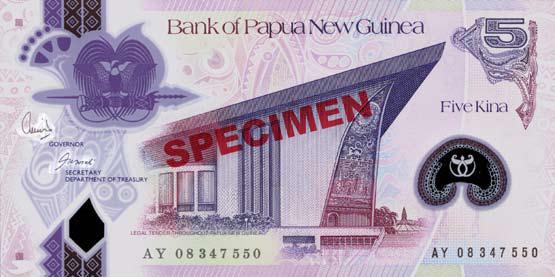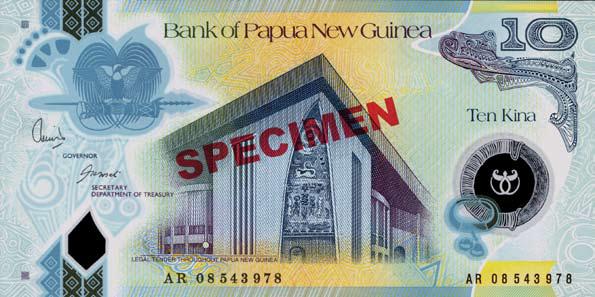Speech by Governor on Launch of New Series K5 and K10 BankNote
Speech by Governor on Launch of New Series K5 and K10 BankNote


- Distinguished guests, ladies and gentlemen, welcome to the launch of our new FIVE KINA and TEN KINA BANKNOTES.May I thank the Minister for Finance and Treasury, Honourable Patrick Pruaitch for accepting our invitation to officiate on this important occasion.
The Bank of Papua New Guinea has timed the release of the new polymer K5 and K10 banknotes to coincide with the Kina and Toea Day, which is on the 19th of April 2008. Because the 19th of April this year falls on this Saturday, we have decided to bring this event forward to today so that we can commence issuing the new notes from Friday onwards. This now completes our programme to have a family of banknotes showing the National Parliament building on the front.
Ladies and Gentlemen, since Papua New Guinea introduced the Kina and Toea thirty-three years ago on 19th April 1975, our family of banknotes and coins have changed reflecting the development of the economy, business activity and world-wide trends. For the banknotes, we started off with the 2 Kina, 5 Kina and 10 Kina notes, then introduced the 20 Kina banknote in 1978, the 50 Kina banknote in 1989 and the 100 Kina banknote in 2005. Similarly for coins, we began with the 1 toea, 2 toea, 5 toea, 10 toea, 20 toea and 1 Kina coins in 1975. This was followed by the South Pacific Festival of Arts commemorative 50 toea coin in 1980. The 1 and 2 toea coins were withdrawn from circulation in 2006 when it was clear they had become redundant and the larger sized 1 Kina coin replaced by a smaller sized coin.
Over the years, the Bank has issued banknotes and coins to commemorate .special and significant events and milestones in the history of our country. These include events such as the South Pacific Games, Independence anniversaries and the Bank’s anniversaries.   The Bank has a numismatic (Collectors) programme where rare moments such as today can be captured in specially packed coins and notes (un-cut) full sheets.
Our quality of currency has also evolved over the thirty-three years, reflecting technological developments, changes in world-wide trends on secured currency, and the cost-effectiveness of production and handling. Our banknotes began with paper substrate but since 1991 we have moved on to introducing polymer notes, the second country outside Australia to do so.  We find polymer banknotes more cost-efficient, more durable and last longer, especially in our humid PNG climatic conditions. The new Five Kina polymer banknote to be launched this afternoon is the last denomination to be converted and completes the series of polymer banknotes. Advanced security features are incorporated in the latest series of our banknotes as protection against counterfeiting.
We have also standardized the main theme running throughout all our banknotes. On the back of our banknotes, we retain our traditional forms of money (for the 2, 5, 10 and 20 Kina), the Grand Chief Sir Michael Somare appears on the K50 note depicting our road to nationhood and guardianship of our country. The progress in economic and technological development is reflected on the back of the K100 note.   On the front of each of the banknotes, you will note that we now have the image of the National Parliament. This family of notes using the ‘Parliament Theme’ shows different aspects of the Parliament House together with a smaller image of the National Crest. These are symbols of nationhood.
Papua New Guinea is predominantly a cash-based economy and will remain so for some time. The majority of our people will continue to use cash (coins and banknotes) as the main form of payment in settling their transactions, in conducting their business activities and meeting social obligations. We at the Bank of Papua New Guinea will therefore ensure that our currency are of an acceptable standard, are durable, and longer lasting, given our tropical humid conditions and the frequent and rough handling of currency by the public. For this reason, the Bank has introduced a Clean Bank Note Policy to maintain the standards and increase public awareness of the quality of our currency.
With these few remarks, ladies and gentlemen, it gives me great pleasure to invite our Minister, Honourable Patrick Pruaitch to officially launch the new five and ten kina banknotes.
